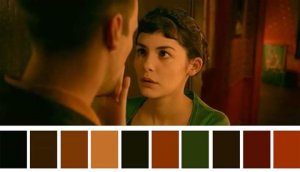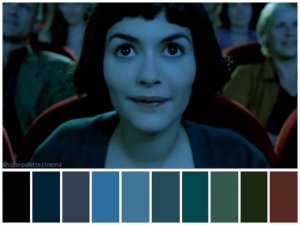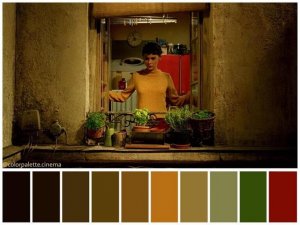Understanding Color in the World of Amélie Poulain

Director and screen-writer Jean-Pierre Jeunet took the world by storm back in 2001, with his hit movie Amélie. One of the things that really made it stand out was the way he used to color to tell the young protagonist’s story. He originally wrote the romantic film for English actress, Emily Watson, but she turned the role down due to difficulties speaking French.
Struggling to find a new lead for his film, Jean-Pierre Jeunet gave the role of Amélie to Audrey Tautou. The young French actress turned out to be a star, masterfully interpreting the titular character.
The plot

The plot revolves around the life of Amélie Poulain, as told by an omnipresent narrator. Amélie is an unusual woman with a fabulous destiny, marked by a variety of different circumstances that we gradually discover as the story unfolds.
Her father, a cold, unfeeling doctor, thinks his daughter is suffering from a heart condition. But what he believes is a heart problem is actually just his daughter’s heart speeding up every time her father touches her.
Because of her “illness”, her father decides that Amélie will be home-schooled by her mother, a professional teacher and serious hypochondriac. Unfortunately, Amélie’s mother dies horribly, crushed by a woman who threw herself from the top of Notre Dame Cathedral.
This event causes her father to withdraw even further, confining himself to tending the shrine to his dead wife at the bottom of the garden. Isolated from the world and deprived of social interaction, young Amélie develops a vivid imagination. This leads her to develop a curious interest in life’s little details and pleasures.
When she turns 18, Amélie decides to leave her family home. Her world shifts to a tiny old apartment, where she is surrounded by unusual people. Madeleine, the concierge, Collignon, the grocer, his assistant Lucien, and ablind beggar who wanders the street from the subway to the cafe.
But her favorite neighbor is Raymond Dufayel, a painter with a passion for Renoir’s The Luncheon of the Boating Party. Dufayel has a rare illness, which earned him the nickname, “the glass man”.
Amélie works in a cafe called The Two Windmills, alongside Suzanne, the owner, and Georgette, a hypochondriac tobacconist, and Gina, her fellow waitress. Even the customers at the cafe are unusual.
Amélie, a doer of good deeds

Amélie tries to help others by fixing different aspects of their lives, without them even realizing it. However, this isn’t enough for her. Beneath it all, we see that Amélie lacks purpose in her own life.
Throughout the movie, there are references to a number of different artists and artistic movements. Sometimes Jeunet incorporates them directly into the set (such as the artwork on Amélie’s wall, or the painting by Renoir); other times, there are simply clues, alluding to specific works or styles.
Understanding color in Amélie

All in all, Amélie is a very expressive movie, both in terms of aesthetic and plot. Even the soundtrack is fascinating. But one of the most noticeable features is the color palette chosen by director Jeunet.
Jeunet himself explained that he took much of his inspiration from the works of Brazilian painter, Juárez Machado. The most common colors are red, green and blue. Each of these colors is used to demonstrate specific emotions as they’re experienced by the characters. In several interviews, Jeunet confessed that he wanted every scene to look like a painting, creating a memorable snapshot.
The different colors that appear throughout the movie allow us to identify the characters’ emotions. For example, red is a sign of Amélie’s warm and loving temperament.
Amélie’s apartment is decorated in red tones, and often features in her outfits as well. We can also see glimmers of red in the phone booth where we first meet Nino – Amélie’s love interest – or in the red hat of her father’s garden gnome.
The color green serves as a contrast to red, and features in multiple scenes throughout the movie. Amélie herself wears a mixture of red and green outfits. The red phone booth where we meet Nino contrasts with the green backdrop of the Paris subway.
Blues symbolize the sad, solitary side of Amélie’s personality. She has always been a shy and reserved person, searching for the love her parents denied her. Among Amelie’s belongings is a small blue lamp in the shape of a toadstool. In some scenes, Amélie and Nino also use blue posters to communicate with one another.
Color in the world of Amélie Poulain – light and photography

We should also talk about the excellent work of the director of cinematography, Bruno Delbonnel. By using wide, slow angles, he tries to show us Amélie’s deep feelings of loneliness and isolation. The camera movements are also unusual. Tracking features heavily in the movie and often finishes with a close-up on a character’s face.
The lighting is soft and slightly yellow in color, even during scenes that take place in the middle of the day. This gives the impression that the whole film takes place at dusk.
Special effects are used only occasionally, to demonstrate the characters’ imagination, thoughts, and feelings.
In conclusion, you could say that director Jean-Pierre Jeunet wanted to show the world the most romantic and wonderful side of Paris, through the medium of color – the colors of Amélie Poulain.
Jeunet’s use of elements such as light and color is truly impressive and reveals the complex array of emotions that make up Amélie’s world.
Director and screen-writer Jean-Pierre Jeunet took the world by storm back in 2001, with his hit movie Amélie. One of the things that really made it stand out was the way he used to color to tell the young protagonist’s story. He originally wrote the romantic film for English actress, Emily Watson, but she turned the role down due to difficulties speaking French.
Struggling to find a new lead for his film, Jean-Pierre Jeunet gave the role of Amélie to Audrey Tautou. The young French actress turned out to be a star, masterfully interpreting the titular character.
The plot

The plot revolves around the life of Amélie Poulain, as told by an omnipresent narrator. Amélie is an unusual woman with a fabulous destiny, marked by a variety of different circumstances that we gradually discover as the story unfolds.
Her father, a cold, unfeeling doctor, thinks his daughter is suffering from a heart condition. But what he believes is a heart problem is actually just his daughter’s heart speeding up every time her father touches her.
Because of her “illness”, her father decides that Amélie will be home-schooled by her mother, a professional teacher and serious hypochondriac. Unfortunately, Amélie’s mother dies horribly, crushed by a woman who threw herself from the top of Notre Dame Cathedral.
This event causes her father to withdraw even further, confining himself to tending the shrine to his dead wife at the bottom of the garden. Isolated from the world and deprived of social interaction, young Amélie develops a vivid imagination. This leads her to develop a curious interest in life’s little details and pleasures.
When she turns 18, Amélie decides to leave her family home. Her world shifts to a tiny old apartment, where she is surrounded by unusual people. Madeleine, the concierge, Collignon, the grocer, his assistant Lucien, and ablind beggar who wanders the street from the subway to the cafe.
But her favorite neighbor is Raymond Dufayel, a painter with a passion for Renoir’s The Luncheon of the Boating Party. Dufayel has a rare illness, which earned him the nickname, “the glass man”.
Amélie works in a cafe called The Two Windmills, alongside Suzanne, the owner, and Georgette, a hypochondriac tobacconist, and Gina, her fellow waitress. Even the customers at the cafe are unusual.
Amélie, a doer of good deeds

Amélie tries to help others by fixing different aspects of their lives, without them even realizing it. However, this isn’t enough for her. Beneath it all, we see that Amélie lacks purpose in her own life.
Throughout the movie, there are references to a number of different artists and artistic movements. Sometimes Jeunet incorporates them directly into the set (such as the artwork on Amélie’s wall, or the painting by Renoir); other times, there are simply clues, alluding to specific works or styles.
Understanding color in Amélie

All in all, Amélie is a very expressive movie, both in terms of aesthetic and plot. Even the soundtrack is fascinating. But one of the most noticeable features is the color palette chosen by director Jeunet.
Jeunet himself explained that he took much of his inspiration from the works of Brazilian painter, Juárez Machado. The most common colors are red, green and blue. Each of these colors is used to demonstrate specific emotions as they’re experienced by the characters. In several interviews, Jeunet confessed that he wanted every scene to look like a painting, creating a memorable snapshot.
The different colors that appear throughout the movie allow us to identify the characters’ emotions. For example, red is a sign of Amélie’s warm and loving temperament.
Amélie’s apartment is decorated in red tones, and often features in her outfits as well. We can also see glimmers of red in the phone booth where we first meet Nino – Amélie’s love interest – or in the red hat of her father’s garden gnome.
The color green serves as a contrast to red, and features in multiple scenes throughout the movie. Amélie herself wears a mixture of red and green outfits. The red phone booth where we meet Nino contrasts with the green backdrop of the Paris subway.
Blues symbolize the sad, solitary side of Amélie’s personality. She has always been a shy and reserved person, searching for the love her parents denied her. Among Amelie’s belongings is a small blue lamp in the shape of a toadstool. In some scenes, Amélie and Nino also use blue posters to communicate with one another.
Color in the world of Amélie Poulain – light and photography

We should also talk about the excellent work of the director of cinematography, Bruno Delbonnel. By using wide, slow angles, he tries to show us Amélie’s deep feelings of loneliness and isolation. The camera movements are also unusual. Tracking features heavily in the movie and often finishes with a close-up on a character’s face.
The lighting is soft and slightly yellow in color, even during scenes that take place in the middle of the day. This gives the impression that the whole film takes place at dusk.
Special effects are used only occasionally, to demonstrate the characters’ imagination, thoughts, and feelings.
In conclusion, you could say that director Jean-Pierre Jeunet wanted to show the world the most romantic and wonderful side of Paris, through the medium of color – the colors of Amélie Poulain.
Jeunet’s use of elements such as light and color is truly impressive and reveals the complex array of emotions that make up Amélie’s world.







